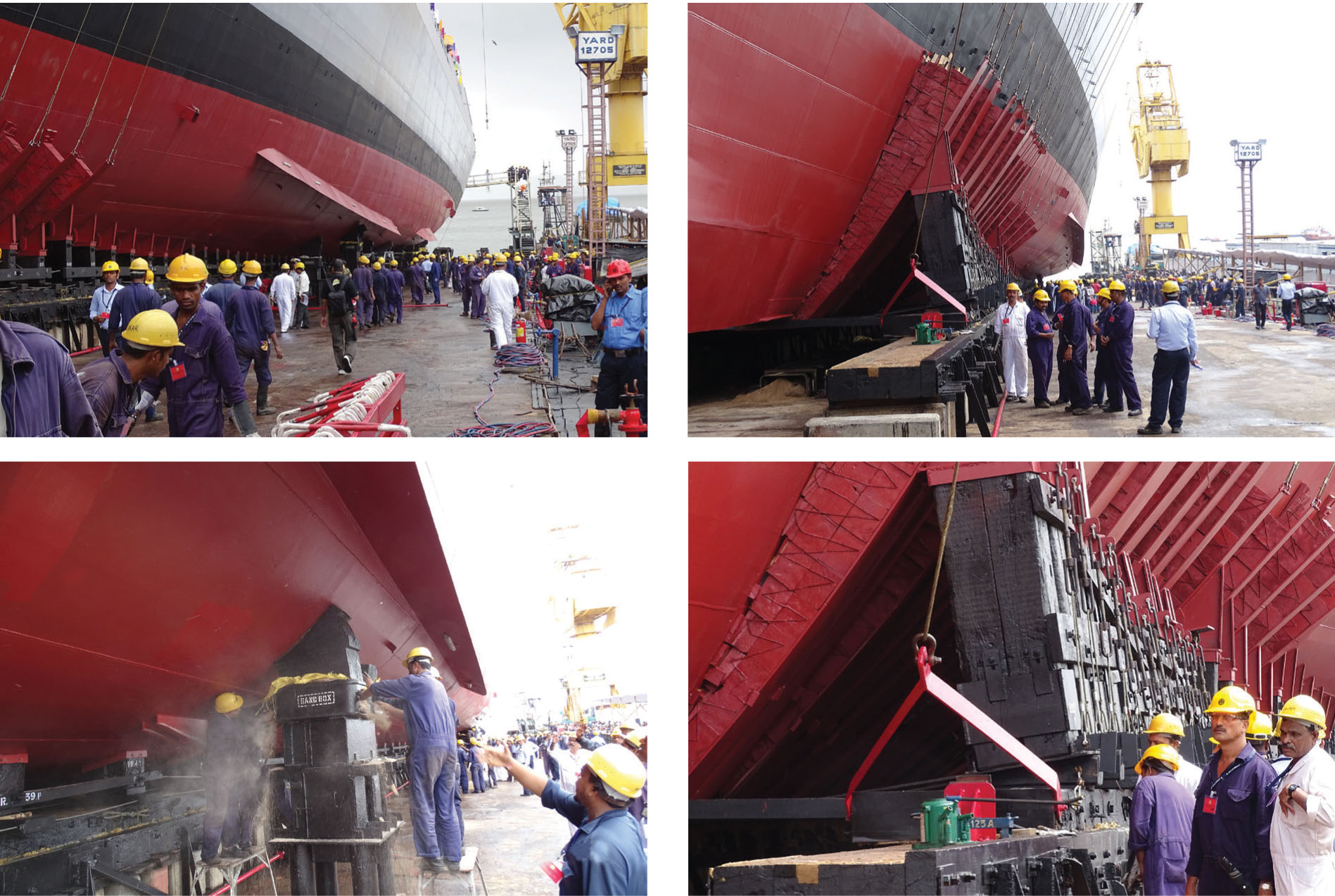The Indian Navy has 41 vessels of various types under construction including; an aircraft carrier, destroyers, frigates, corvettes, conventional and nuclear-powered submarines. The Indian Navy’s intention is to build a 200 ship navy over a 10-year period. In an endeavor towards achieving that goal, India has transformed itself from a buyer’s navy to a builder’s navy.
The Indian Navy has been focusing on developing indigenous platforms, systems, sensors and weapons as part of the nation’s modernisation and expansion of its maritime forces.
The Indian Navy has 41 vessels of various types under construction including; an aircraft carrier, destroyers, frigates, corvettes, conventional and nuclear-powered submarines. The Indian Navy’s intention is to build a 200 ship navy over a 10-year period. In an endeavor towards achieving that goal, India has transformed itself from a buyer’s navy to a builder’s navy.
All 41 ships under construction are being produced indigenously in Indian ships yards, both, the public and the private. Notwithstanding that some of the projects have suffered from long delays and cost overruns, the overall efforts are progressing well.
Increasing People’s Liberation Army Navy interest in the Indian Ocean region has led the Indian Navy to invest more in anti-submarine ships, such as the Kamorta-class corvette, long-range maritime reconnaissance aircraft, and ships such as the Saryu-class patrol vessel and unmanned aerial vehicles such as the IAI Heron-1. However, the lack of a strong submarine fleet has diminished its capabilities to some extent.
Directorate of Naval Design for designing state of the art warships and contributing towards achieving Indian Navy’s dream of transforming from a “Buyers” to a “Builders” Navy.
Nevertheless, the Destroyers like Mormugao which are being built by Mazgaon Docks under Project-15B, will, to a very large extent fill these gaps, especially during the blue water operations.
In naval terminology, a destroyer is a faster speed warship which is highly maneuverable having a long-endurance. This type of a warship is intended to escort larger vessels in a fleet, convoy or battle group and defend them against smaller powerful short-range attackers.
Destroyers have a proud tradition of anti-submarine warfare, but the Navy’s modern versions are multi-mission nightmares for an opposing threat. Capable of operating in battle groups or on their own, they have similar guided-missile capabilities to cruisers and take part in a wide range of missions, including supporting carrier and expeditionary strike groups and surface strike groups.
Moving faster towards indigenization and developing credible Blue Water capabilities, India is enhancing its ‘Made in India’ Destroyer’s fleet. A number of ships are being built under Project 15 and its follow on, 15 A and 15 B.
Project 15 saw Delhi, Mysore and Mumbai followed by Project 15 A to include Kolkata, Kochi and Chennai. And now under Project 15 B, four Destroyers are being built. Two have already been launched; Vishakapatnam and Mormugao.
These destroyers are a follow-on of the Project 15A Kolkata-class destroyers, but are considerably more capable due to major improvements in the design, the addition of substantial land-attack capabilities, and the fitting-out of modern sensors and weapons systems.
Mormugao, the second ship of Project 15B, is the latest Guided Missile Destroyer that was launched on the Sep 17, 2016 at Mazgaon Dock Ship Builders Limited (MDL), Mumbai. It is yet another significant milestone in the annals of the Indigenous Warship design and construction programme of India.
With a launch weight of 2844 tonnes, the vessel made its first contact with water at 11:58 AM with full fanfare during the launching ceremony graced by Chief of the Naval Staff, Admiral Sunil Lanba as the Chief Guest.
In keeping with maritime traditions, Smt Reena Lanba, President, Navy Wives Welfare Association (NWWA), broke a coconut on the ship’s bow and launched the ship, as invocation from the Atharva Veda was being rendered.
The ship includes a 4 x 8-cell vertical launch missile system (total of 32) for long distance engagement of shore and sea-based targets.
Speaking on the occasion, the Chief Guest, Admiral Sunil Lanba, Chief of the Naval Staff said that “this event is yet another moment of truth for the Indian Navy and India’s quest for self-reliance and indigenisation. The Indian Navy stands fully committed to the call of ‘Make in India’ and we are extremely proud of the fact that all of our warships and submarines on order today are being constructed within the country”.
He further added that this also is “an affirmation of our resolve that the Indian Navy should attain a size and capability that is commensurate with India’s growing stature in the world, our national maritime interests, and our commitment to cooperation and collaboration towards ensuring secure seas for shaping a favourable and positive maritime environment.
The Admiral also commended the synergic partnership of MDL, Indian Navy, Defence Research and Development Organization (DRDO), Ordnance Factory Board (OFB), Bharat Electronics Limited (BEL), other public sector enterprises and the private industry in ensuring that force levels are made available to meet India’s National strategic objectives. He also congratulated Director General Naval Designs (DGND) and his team at Directorate of Naval Design for designing state of the art warships and contributing towards achieving Indian Navy’s dream of transforming from a “Buyers” to a “Builders” Navy.
Project 15B ships feature cutting edge advanced technology and are comparable to the best ships of similar class anywhere in the world. These ships have been designed indigenously by the Directorate of Naval Design, New Delhi.
Each ship spans 163 metres in length and 17.4 metres at beam and displaces 7300 tonnes. These ships will be propelled by four gas turbines in Combined Gas and Gas (COGAG) configuration and are capable of achieving speeds in excess of 30 knots with a maximum endurance of 4000 nm. The P15B destroyers incorporate new design concepts for improved survivability, sea keeping, stealth and ship manoeuvrability. Enhanced stealth features have been achieved through shaping of hull and use of radar transparent deck fittings which make these ships difficult to detect. P 15B ships will be equipped to carry and operate two multiple role helicopters.
These ships have been designed for a complement of 50 officers and 250 sailors. The accommodation and working spaces have been designed with special emphasis on ergonomics and habitability.
These ships are packed with an array of state of the art weapons and sensors, including vertically launched missile system for long distance engagement of shore, sea-based and air targets. With significant indigenous content, these ships are a true hall-mark of self reliance attained by our country in warship design and ship building.
These ships can truly be classified as possessing a Network of Networks, as they are equipped with Integrated Platform Management System (IPMS), Ship Data Network (SDN), Automatic Power Management System (APMS) and Combat Management System (CMS). While control and monitoring of machinery and auxiliaries is achieved through the IPMS, power management is done using the APMS. The CMS performs threat evaluation and resource allocation based on the tactical picture compiled and ammunition available onboard. The SDN is the information highway on which data from all the sensors and weapons ride.
Stealth has been a major thrust area in P15B design. Enhanced stealth features have been achieved through shaping of hull and use of radar transparent deck fittings which make these ships difficult to detect. The ship embodies features such as Multiple Fire Zones, Total Atmospheric Control System (TACS) for Air Conditioning, Battle Damage Control Systems (BDCS), Distributional Power Systems and Emergency DA to enhance survivability and reliability in emergent scenarios.
The ship’s “fire power” consists of sophisticated weapons-sensor suite including vertically launched Surface to Air Missiles (SAM) and Surface-to-Surface Missiles (SSM) for long distance engagement of shore and sea based targets. It is also noteworthy that this ship has significantly high indigenous content, in the form of weapons, machinery and material. These ships therefore showcase the Nation’s growing capability in developing and delivering complex warships, which serves as a true hall mark of self reliance attained by our country in warship design and construction. This high level of indigenization has been achieved through participation of both public and private sector.
In order to have an overview of the capabilities, INS Mormugao will have on commissioning, it is essential to glean over the operational attributes of INS Kochi. Vishakapatnam class being a follow on of Kolkata class, thus makes all that sense.
INS Kochi is packed with an array of state-of-the-art weapons. INS Kochi’s anti-submarine arsenal consists of Indigenous Rocket Launchers (IRL), Indigenous 4x Twin-tube Torpedo Launchers (ITTL), 2 x antisubmarine rockets and bow-mounted new generation HUMSA Sonar Dome which makes it totally a destroyer.
The ship includes a 4 x 8-cell vertical launch missile system (total of 32) for long distance engagement of shore and sea-based targets.
The Ship is also armed with Anti-Air Barak 8 missiles which designed to defend any type of airborne threat including aircraft, helicopters, anti-ship missiles, and UAVs as well as cruise missiles and combat jets.
There are also 16 Brahmos supersonic Anti-Ship missiles armed with INS Kochi.
INS Kochi has 76 mm Super Rapid Gun Mount (SRGM) and AK 630 Close In Weapon System (CIWS) designed to take on air and surface targets.
The INS Kochi is equipped to operate two Sea king Medium Lift Transport/utility helicopter or HAL Dhruv Multirole Utility helicopter or Both 1 x 1.
While the weaponry on Vishakapatnam Class destroyers will continue to be same as the Kolkata Class, however there will be a marked improvement in Navigation, Stealth and Electronic Warfare suites on INS Vishakapatnam and Mormugao.
The ship has built with special shaping hull and radar-transparent deck fittings is order to achieved advanced stealth features. For enhancing the sonar acoustic performance there is the introduction of sonar dome mounted on the forward part of ship/hull or on Bow. It is the second of its kind in an indigenous naval platform.
The Electronic Warfare and decoys systems includes Elbit Systems Deseaver MK II countermeasures system and Defensive aids suite 1.
INS Kochi is equipped by Advanced BEL Electronic Modular Command & Control Applications (EMMCCA Mk 4) combat management system. It also incorporated with Thales LW-08 D-band air search radar, IAI EL/M-2248 MF-STAR(Threat Alert Radar) S-Band AESA Multi-Function Radar and IAI EL/M-2238 L-band Star surveillance radar. There are two sonar integrated; BEL HUMSA-NG Bow sonar and BEL Nagin active towed array sonar.







